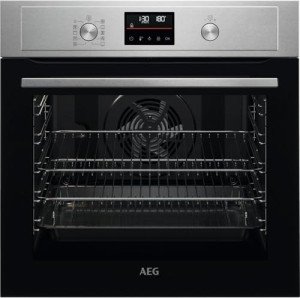Why You Should Concentrate On Enhancing Self Cleaning Oven Efficiency

The Efficiency of Self-Cleaning Ovens: A Comprehensive Overview
When it concerns keeping cooking area devices, few innovations have actually significantly changed the cleaning process as much as self-cleaning ovens. Their capability to assist in a practically hands-free cleaning experience has made them a popular choice among contemporary house owners. This article explores the efficiency of self-cleaning ovens, checking out how they work, their benefits, drawbacks, and tips for usage.
Comprehending Self-Cleaning Ovens
Self-cleaning ovens utilize heats to burn food residues, grease, and gunk, turning them into ash that can be easily wiped away. Generally, there are 3 primary kinds of self-cleaning techniques used in ovens:
- Pyrolytic Cleaning: This is the most typical self-cleaning approach where the temperature level rises to around 900 ° F(482 ° C). The high heat incinerates food particles, leaving just a percentage of ash.
- Steam Cleaning: This method uses steam to soften food residues, making them simpler to clean away. The process generally takes less time and runs at lower temperature levels compared to pyrolytic cleaning.
- Catalytic Cleaning: This technology involves special panels coated with a porous substance that takes in spills and splatters during cooking. While not a conventional self-cleaning method, catalytic panels can be wiped down quickly after cooking.
Efficiency Analysis
The efficiency of self-cleaning ovens can be evaluated based on several factors, including energy intake, time savings, cleaning efficiency, and safety.
| Aspect | Pyrolytic Cleaning | Steam Cleaning | Catalytic Cleaning |
|---|---|---|---|
| Temperature level | As much as 900 ° F( | 482 ° C)Approximately 212 ° F( | 100 ° C)Varies (heat during cooking) |
| Cleaning Time | 2 to 4 hours | Thirty minutes to 1 hour | Continuous during cooking |
| Energy Consumption | High (due to heat) | Moderate | Low (during regular use) |
| Effectiveness | Extremely efficient | Moderately efficient | Efficient for light spills |
| Safety | Requires cool-down time | Typically safe | Safe when panels are functioning |
Advantages of Self-Cleaning Ovens
- Convenience: The hands-free aspect of self-cleaning ovens is perhaps their greatest appeal. It conserves effort and time compared to traditional cleaning techniques.
- Deep Cleaning: The pyrolytic technique, in particular, is outstanding for getting rid of stubborn baked-on residues that would otherwise require hours of scrubbing.
- Decrease in Cleaning Products: Homeowners typically discover they need less harsh chemical cleaners, adding to a much healthier kitchen area environment.
- Increased Lifespan: A tidy oven can potentially last longer considering that the heats help in reducing the accumulation of hazardous residues.
Downsides of Self-Cleaning Ovens
- High Energy Use: The pyrolytic cleaning process can utilize a considerable quantity of energy, which may result in increased energy bills, specifically if done frequently.
- Heat Generation: During the self-cleaning process, the oven can become extremely hot, resulting in potential safety issues if there are children or pets in the home.
- Emissions: Some issues have actually been raised about the emissions triggered by burning residues, which might negatively affect air quality in smaller sized kitchens.
- Use on Components: Regular usage of high-temperature cleaning cycles might cause endure specific oven parts gradually.
Tips for Optimal Use of Self-Cleaning Ovens
To take full advantage of the efficiency and usefulness of a self-cleaning oven, homeowners ought to think about the following tips:
- Refer to the Manual: Always seek advice from the user handbook for specific cleaning instructions and guidance customized to the model you own.
- Tidy Regularly: Although self-cleaning ovens are designed to make life simpler, routine usage of the self-cleaning function can prevent accumulation and lower the number of cycles required.
- Get rid of Accessories: Always eliminate racks, thermometers, and any other devices before initiating a self-cleaning cycle to avoid damage.
- Guarantee Good Ventilation: Because high temperatures and possible emissions are involved, ensure sufficient kitchen ventilation throughout the self-cleaning process.
- Keep a Watchful Eye: While ovens are usually safe, it's an excellent practice to keep an eye on the self-cleaning process, particularly throughout the first few uses.
FAQs About Self-Cleaning Ovens
1. How often should I utilize the self-cleaning feature on my oven?
It is usually recommended to use the self-cleaning function every 3 to 6 months, depending on usage. More frequent usage may be required for those who bake or roast regularly.
2. Are self-cleaning ovens safe for animals and kids?
While self-cleaning ovens are safe, the process produces significant heat. It's essential to keep kids and family pets away from the kitchen area during the self-cleaning cycle to avoid mishaps.
3. Can Self Cleaning Oven Sale use regular oven cleaners together with self-cleaning features?
No, utilizing regular oven cleaners within a self-cleaning oven is prevented as it can damage the oven's interior and cause dangerous fumes.
4. Is steam cleaning as reliable as pyrolytic cleaning?
Steam cleaning is typically less effective for hard, burnt-on residues compared to pyrolytic cleaning however is a faster and more secure alternative for light spills.
Self-cleaning ovens represent a significant improvement in cooking technology, using convenience and effective cleaning options for modern-day kitchens. With mindful usage and an understanding of both their strengths and restrictions, house owners can enjoy the benefits of these devices while keeping a clean and efficient cooking environment. As technology continues to evolve, the future might bring much more innovations in the world of kitchen cleaning efficiency.

